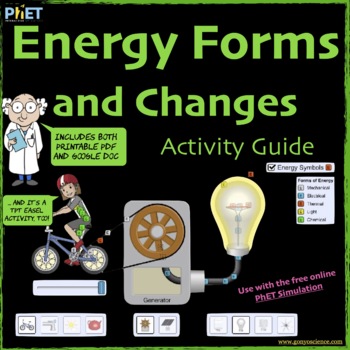PhET Energy Forms and Changes Activity Guide
- Zip
- Google Apps™
- Easel Activity

Also included in
- Now includes both printable PDF and Google Slides versions!The PhET Physics Activity Guides are used along with the free *Next Generation PhET Simulations. All activity guides are in PDF and Google Slides formats and include an answer key and a Getting Started Guide for teachers.Your students will hPrice $27.00Original Price $30.00Save $3.00
Description
The PhET: Energy Forms and Changes Activity Guide is used along with the free *Next Generation PhET Simulation “Energy Forms and Changes”. Students will discover the different forms of energy and how they can change from one form into another within a system, specifically:
- how energy will flow when objects are heated or cooled
- how energy can change from one form of energy into another
- how energy is conserved within a system
- to predict how energy will change as it moves from one part of a system to another
- to design an energy system that will convert energy in predictable ways
The activity guide takes students through the 2 parts of the simulation: Intro and Systems. Students are encouraged to make predictions as to the effects of changes in energy source and the various components of the energy system.
Your students will hit the ground running without the need for a lengthy introduction from you. Just print the activity guide or share from your Google Drive. Students can follow the link to the free simulation. The best part is that students don’t even know they are learning, they just think they are having fun!
The activity guide includes PDF, Google Doc, and TPT Easel versions for printing worksheets, sharing via Google Drive or Google Classroom, or TPT Digital Activities. This lesson is perfect for face to face, hybrid, or remote learning!
This product includes the Activity Guide in color (pdf), Activity Guide for photocopying (pdf), Activity Guide (Google Doc), Answer Key, and a Getting Started Guide for teachers.
*PhET simulations are fun, interactive, research-based simulations of physical phenomena. As students interact with the simulation, they get immediate feedback about the affects of the changes they made. All PhET simulations are freely available from the PhET website (phet.colorado.edu) and are easy to use and incorporate into the classroom. The new Next Generation sims utilize HTML 5 which allows them to run in any modern web browser on most devices including Chromebooks and tablets like the iPad! Learn more about using PhET Simulations with your students.







